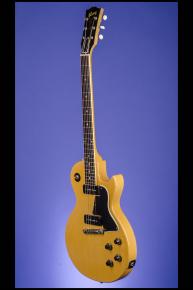An Exceptionally Fine 1957 Gibson Les Paul TV Special
1957 Gibson Les Paul "TV" Special
This early 1957 12 3/4-inch-wide solid mahogany bodied guitar weighs just 7.60 lbs. One-piece mahogany neck with a fat nut width of just over 1 11/16 inches, a scale length of 24 3/4 inches and a wonderful thick profile. Bound Brazilian rosewood fretboard with 22 original thin frets and inlaid pearl dot position markers. Headstock with inlaid pearl "Gibson" logo and "Les Paul Special" silk-screened in gold. Single-line Kluson Deluxe strip tuners with white plastic oval buttons. Serial number "7 3851" inked on in black on the back of the headstock. Two very hot P-90 pickups with outputs of 9.20k and 7.92k. Both black plastic pickup covers stamped on the underside "UC-452-B / 2". Five-layer (black/white/black/white/black) plastic pickguard with four screws. Four controls (two volume, two tone) on lower treble bout, plus three-way pickup selector switch on upper bass horn. Black plastic bell-shaped "Bell" knobs. The potentiometers are stamped: "134 649" (Centralab December 1956). Original combination wrap-over bar bridge/tailpiece. There are a few small marks/indentations on the edges of the body and a small ding (just over 1/8 inch square) on the treble-side of the back of the neck, behind the second fret. There is also a small discoloration mark on the back of the neck behind the 9th fret (almost certainly due to a prolonged time on a guitar stand). With all that said, this is one of the cleanest, nicest playing, incredible sounding TV Special that we have handled, and we will still give it a (9.25) exceptionally fine rating. Housed in the original Gibson 'Lifton' four-latch, 'California Girl' shaped brown hardshell case with pink plush lining (9.00).
"In 1955, Gibson launched the Les Paul TV, essentially a Junior but with a finish that the company referred to variously as 'natural', 'limed oak' and (more often) 'limed mahogany'. Surviving original TV models from the 1950s reveal a number of different colours, with earlier examples tending to a rather turgid beige, while later ones are often distinctly yellow. Today there is much debate about where the model's TV name came from...One such theory says that the TV name was used because the pale colour of the finish was designed to stand out on the era's black-and-white TV screens. This seems unlikely, not least because pro players appearing on television would naturally opt for a high-end model... Others say the guitar followed the look of fashionable contemporary furniture, where the expression 'limed' was used for a particular look. Certainly Gibson promoted the Les Paul TV as being 'the latest in modern appearance'. There's also been a suggestion that 'TV' might be a less than oblique reference to the competing blond-coloured Telecaster made by Fender. But in fact the name was coined to cash in on Les Paul's regular appearances at the time on television on The Les Paul & Mary Ford Show. This was effectively a sponsored daily ad for a toothpaste company, for which the couple signed a $2 million three-year contract in 1953. Gibson reasoned that if you'd seen the man on TV, well, now you could buy his TV guitar. Following a reader's enquiry to Guitar Player in the 1970s, a Gibson spokesman confirmed that 'the Les Paul TV model was so named after Les Paul's personal Listerine show was televised in the 1950s'" (Tony Bacon, 50 Years of the Gibson Les Paul, p. 28).
"In 1955, the original line of Les Paul models was completed with the addition of the Special, effectively a two-pickup version of the Junior, finished in the TV's beige colour (but not called a TV model -- a cause of much confusion since). The Special appeared on the company's September 1955 price list at $182.50" (Tony Bacon, 50 Years of the Gibson Les Paul, p. 29).
1958 was the last year for the 'single-cut' TV Special. The Gibson shipping records show that out of a total of 1,647 Les Paul TV Junior and Special models made between 1955 and 1958.












